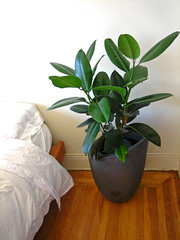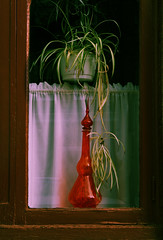Grow fresh air in home or office
By JULIE BAWDEN DAVIS
Think of ways to combat indoor air pollution and you likely envision man-made air cleaners – devices designed to control what can be a significant health threat. Chances are, you didn’t think of the cure nature can provide.
The best method for improving indoor air quality is to grow houseplants, said scientist Bill Wolverton, author of "How to Grow Fresh Air: 50 Houseplants that Purify Your Home or Office" (Penguin, 1997).
Wolverton worked almost 20 years for the National Aeronautics and Space Administration, developing technology that would allow humans to live in a closed environment on the moon or Mars. Through this pioneering research he discovered that houseplants are the quickest and most effective filters of common, dangerous air pollutants such as formaldehyde, benzene, xylene and ammonia. All can cause a number of ailments, such as asthma and allergies, and the broader illness now recognized as "sick-building syndrome."
Wolverton and his colleagues have placed houseplants in sealed chambers and exposed them to hundreds of chemicals. "We’ve found that plants literally suck these chemicals out of the air," he said. "After some study, we’ve unraveled the mystery of how plants can act as the lungs and kidneys of buildings," cleaning out impurities as these organs do in the human body.
Plants clean indoor air in two ways.
They absorb pollutants into their leaves. The plants transmit the toxins to their roots, where they are transformed into a source of food for the plant.
Plants emit water vapor, which creates a pumping action that pulls dirty air down around the plant’s roots, where it once again is converted into food for the plant.
Plants are especially needed in office buildings. Many of these enclosed spaces have sick-building syndrome, caused in part by toxins given off by office machinery, pressboard furniture and other sources. Wolverton suggests that everyone have a plant on his or her desk, within what he calls our "personal breathing zone." This is an area of 6 to 8 cubic feet surrounding an individual, the area where we spend several hours on a regular basis. In the home this could also be near our bed.
"The closer the plant is to you, the better," Wolverton said. "Even in large, open rooms, a plant within your personal breathing zone really improves the air you breathe."
Although she hasn’t done any scientific tests, florist Pat Gosnell knows from personal experience that plants definitely clean the air. "We’ve got a lot of houseplants in the front of the store and customers always remark on how fresh the air is when they walk in," says Gosnell, who owns Regal Flowers in Orange.
"Plants do definitely decrease gaseous air pollutants such as ammonia in the air," said Bob Phalen, director of the Air Pollution Health Effects Laboratory at the University of California, Irvine. "The downside to this, however, is that moisture in the soil and around pots can lead to mold, and some plants emit allergens and pollens, which can be catastrophic for people with respiratory problems."
According to Wolverton, it’s talk of mold that has limited the use of plants as air cleaners.
"It’s not plants that give off mold and mildew spores, but the soil. Plants actually reduce molds and mildews in the air," he said. "Research shows that plant-filled rooms contain 50 to 60 percent fewer airborne molds and bacteria than rooms without plants."
For those with allergies and respiratory problems, Wolverton suggests growing plants with hydroponics (in water), or covering the top of the soil with a 2-inch layer of gravel. That will dry soon after watering and help reduce mold spores in the air. If pollen is an issue, remove flowers or flower parts from the plant.
TOP 10 AIR CLEANERS
Many common houseplants make great indoor air cleaners. In his book, Wolverton identifies the top 50 plants for cleaning air. While some plants are better at filtering air than others, don’t let that discourage you. "If your favorite plant is lower on the list, then just put more of them in your house and office," Wolverton said.
To filter indoor air, houseplants should be kept clean and in good health.
Keep foliage free of dust by wiping with a damp cloth once a month.
Fertilize with organic food regularly. Unless otherwise noted, the houseplants listed here prefer to approach dryness before watering. As for pests, mealybugs can be removed by spraying with isopropyl alcohol. Thrips and spider mites should be treated with insecticidal soap, and scale insects with horticultural oil.
พืชฟอกอากาศ
ต้นไม้เป็นสิ่งที่จำเป็นอย่างมากสำหรับอาคารสำนักงานต่างๆ. เพราะว่าอาคารเหล่านั้นเป็นสถานที่ปิดขนาดใหญ่ เป็นแหล่งผลิตเชื้อโรคต่างๆ ที่ทำให้เกิดโรคต่างๆ โรคต่างๆ ได้มากมาย เช่นโรคภูมิแพ้ หรือโรคเกี่ยวกับระบบทางเดินหายใจ.
แต่ก็มีความเห็นของ Prof. บางคนที่เป็นความเห็นอีกด้านหนึ่งกับของ Dr. Wolverton. ได้บอกว่าต้นไม้มีข้อจำกัดในเรื่องของเชื้อราบางชนิดซึ่งต้นไม้ไม่อาจจะทำให้อากาศบริสุทธิ์ได้เลยซะทีเดียว.
Dr. Wolverton. ได้อธิบายว่า ไม่ใช่ต้นไม้หรอกที่เป็นสาเหตุของเชื้อราในอากาศ แต่เป็นเรื่องของวัสดุปลูก เสียมากกว่า การที่เรารดน้ำต้นไม้ในดินและเกิดความชื้นขึ้นในดิน ทำให้เชื้อราบางชนิดเจริญเติบโตได้ดีและเมื่อ นำต้นไม้ไปไว้ในอาคารก็จะเกิดการกระจายเชื้อภายในอากาศ
ทางแก้ปัญหานั้นก็คือการไม่ใช้ดินที่เป็นวัสดุปลูก ที่ไม่ใช่ดิน เช่นการใช้หินภูเขาไฟ การใช้วัสดุปลูกที่เป็นดินเหนียวเผาไฟ การใช้กรวด ซึ่งเราจะกล่าวถึงในที่นี้ก็คือ ระบบ "Hydroculture" ซึ่งเป็นระบบที่ไม่ใช้ดินแต่จะเลือกใช้วัสดุปลูกที่รากสามารถเกาะได้แล้วมีมวลเบา
ระบบ "Hydroculture เป็นที่นิยมมากในประเทศแถบยุโรป มีการพัฒนาระบบวัดระดับน้ำและมีการทดลองกับต้นไม้ต่างๆ ตลอดจนการให้อาหารพืชด้วยปุ๋ยต่างๆ ซึ่งเป็นหลักการเดียวกันกับระบบ Hydroponics ซึ่งใช้ปลูกผักรับประทานเพียงแต่ต้นไม้ที่ปลูกในกระถางก็จะมีวิธีที่ไม่ซับซ้อนและไม่จำเป็นต้องมีระบบที่ยุ่งยาก
พันธุ์ไม้ 50 ชนิดที่ Dr. Wolverton. ได้ทำการทดลองแล้วมีประสิทธิภาพในการดูดสารพิษต่างๆ มีดังนี้ (ขอยกตัวอย่าง 25 ชนิด)
1) ต้นหมากเหลือง (Yellow palm)
2) ต้นจั๋ง ( Lady palm)
3) ปาล์มไผ่ (Bamboo palm)
4) ต้นยางอินเดีย (Rubber plant)
5) หมากผู้หมากเมีย (Dracaena "Jenet Craig")
6) ต้นตำลึง (Enlish Ivy)
7) ต้นปาล์ม ( Dwarf date palm)
8) ต้นไทร (Ficus Alii)
9) บอสตัสเฟิร์น (Boston fern)
10) เดหลี ( Peace Lily)
11) วาสนา (Dracaena "Massangeana")
12) พลูด่าง ( Philodendron oxycardium)
13) จันผาขอบแดง ( Dragon Tree)
14) มรกตแดง (Rec Emerald Philodengron)
15) ต้นลิ้นมังกร ( Sansevieria trifasciata)
16) สาวน้อยปะแป้ง (Diffendachia camilla)
17) ต้นสนฉัตร (Norfolk Island pine)
18) ต้นกล้วย (Dwarf banana)
19) ต้นหญ้าประดับ ( Lily Turf)
20) ต้นโกสน (Croton)
21) กล้วยไม้ ( Moth Orchid)
22) สับประรดสี ( Urn Plant)
23) คล้า (Calathea Makoyana)
24) ต้นหน้าวัว ( Anthurium)
25) เขียวหมื่นปี ( Chinese Evergreen)
0 ความคิดเห็น:
Labels
- astrology program (4)
- biodiesel (1)
- comic (1)
- condo plan (39)
- deva (2)
- dharma (4)
- egypt (12)
- english terms (5)
- ergonomic (1)
- feng shui (7)
- FFI (3)
- fuel (1)
- gas (1)
- gasoline (1)
- gemstone (3)
- health (3)
- heroes (5)
- hobby (6)
- jagannatha hora (2)
- knowledge (17)
- make merit (1)
- maps (1)
- mlm (1)
- mpg-cap (1)
- mpg-mega-crumb (1)
- my trip (5)
- my wish list (5)
- numerology (3)
- oil (1)
- rich dad poor dad (1)
- rober kiyosaki (1)
- save (1)
- talismans (4)
- tv show (8)
- vedic astrology (7)
- นามมงคล (2)
- พ่อรวยสอนลูก (1)
- เลขศาสตร์ (3)
- เสริมสิริมงคล (6)









